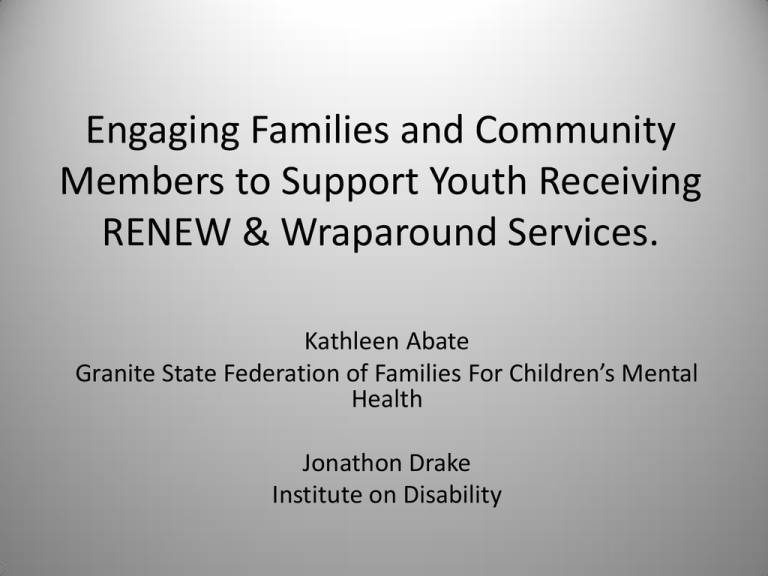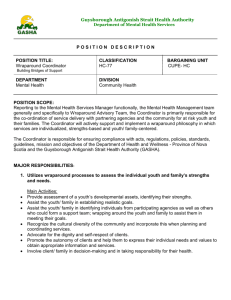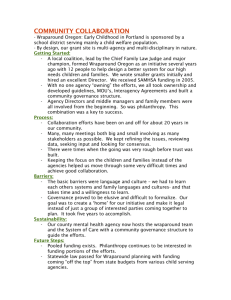Engaging Families and Community Members to Support Youth Receiving
advertisement

Engaging Families and Community Members to Support Youth Receiving RENEW & Wraparound Services. Kathleen Abate Granite State Federation of Families For Children’s Mental Health Jonathon Drake Institute on Disability What is Wraparound? • Wraparound is a planning process, based in a clear set of values and principles. • Wraparound teams have dynamic rather than static membership. • Wraparound is a process that begins with the strengths of individual youth and families. • Wraparound is not a service or set of services. • Wraparound is a good tertiary level planning intervention • • • • What is Wraparound? Wraparound is a process that is child centered and family focused Wraparound connects families to supports and services in their communities, and always includes a mix of public, private, and natural supports. Wraparound is a process that respects families’ culture and values. Wraparound is led by a trained facilitator. Wraparound Is Not: • • • • • • A specific set of services offered A typical team meeting Any meeting held without family or youth An immediate or quick solution A crisis intervention or response A standing interagency team Wraparound in Simplest Terms • Work until it works. • When barriers arise--- People haven’t failed- the plan has failed. • Strengths plus Needs= Actions • Voice and choice. • If it doesn’t feel like help, it probably isn’t. • No shame, no blame Critical Elements of High Fidelity Wraparound • • • • • • • • • Youth Guided Strengths-Based Family-Driven Needs-Driven Individualized Culturally Relevant Unconditional Community-Based Team-Based • • • • • • • • Accountable Accessible Outcome-Based Cost- Effective Flexible Promoting Self-sufficiency Comprehensive Collaborative Common shortcomings in Wraparound– nationally and in New Hampshire •Failing to incorporate full complement of important individuals on the wraparound team. •Failing to engage the youth in community activities the youth does well, or activities that will allow him or her to develop appropriate friendships •Failing to use family/community strengths to plan and implement services •Failing to use natural supports, such as extended family members and community members •Lack of flexible funds to help implement innovative ideas that emerge from the ongoing team planning process •Inconsistent outcome & satisfaction assessment • Under use of trained facilitators- facilitators experience a decrease in confidence and skills. From patterns of WFI element and item scores (Bruns, 2004) RENEW IS…. • A flexible, person-centered support • Driven by the student’s expressed needs, interests, and goals • A service RENEW IS NOT…. • A program • A classroom or school 16 APEX PBIS MODEL Tertiary Prevention: RENEW Intervention ~5% ~15% Secondary Prevention: Specialized Group Systems for Students with At-Risk Behavior Primary Prevention: School-/ClassroomWide Systems for All Students, Staff, & Settings ~80% of Students 17 Children’s Mental Health in A Public Mental Health Triangle Model: Where RENEW/Wrap Fit Hospital Level Care, Placements out of School, Home, Community, Tier 3/Tertiary 2-5% of population: complex challenges, require highly individualized support Intensive Family to Family or Peer Support. RENEW/Wrap Home, School or Community ) Based Group or Individual Supports Tier 2 Family and Youth Support and Education Mental Health Promotion and Prevention, Anti-Stigma and Awareness , Primary Care . 15% of population: Less complex individual and/or group supports, therapies 80% of population: Universal: “universal” health promotion and prevention interventions, broad based assessment activities Big Ideas of RENEW 1. 2. 3. 4. 5. 6. 7. 8. We believe that all students are part of ONE proactive educational system and can successfully complete high school with the proper supports. We know that we can support behavior change. We will teach, reinforce, and build response systems around youth’s needs. We will use evidence based curriculum, instruction, and interventions matched to student needs. We will use data to guide decisions and to build the system to support all youth. We will build professional development (onsite and offsite) and followup modeling and coaching to ensure effective instruction at all levels. We will include families and students as partners in all phases of the process. We will ensure that the staff have the training and support they need to more effectively implement RENEW and to become most efficient with their resources, programs, and services that support youth at risk. RENEW PRINCIPLES • • • • • Self-Determination Unconditional Care Strengths-Based Supports Flexible Resources Natural Supports 20 RENEW Goals • • • • High School Completion Employment Post-secondary Education Community Inclusion 21 RENEW Conceptual Framework Education School-to-Career Transition Children’s Mental Health Youth, Family, RENEW Interagency Collaboration & Wraparound Self Determination Disability 22 RENEW Strategies • • • • • • • • Personal Futures Planning Individualized Team Development and Wraparound Braided (individualized) Resource Development Flexible, or Alternative Education Programming Individualized School-to-Career Planning Naturally Supported Employment Mentoring Sustainable Community Connections 23 Personal Futures Planning 25 RENEW and Wraparound RENEW WRAPAROUND (Bruns, et al., 2008) Self-determination Family voice and choice Individualized Unconditional Care Culturally Competent Persistence Strengths-based Strengths-based Flexible Resources Collaboration Natural Supports Natural Supports Community-based Team Based Team Based Outcome-based Outcome-based 26 Wraparound/RENEW Phases Youth identifiedemotional and behavioral support needs Phase 1: Engagement and futures planning Phase 2:Team DevelopmentInitial Planning Phase 3: Implementation and Monitoring Phase 4: Transition Adult Life Activities, Connections RENEW Applications • RENEW is the intensive intervention for PBIS model dropout prevention projects: APEX, APEX II, APEX III in New Hampshire (replicated in Illinois). • RENEW was the primary intervention for a US DOE funded Juvenile Justice community re-entry project. • RENEW is being a service of 6 of NH’s community mental health centers • Since 1996, over 250 youth have participated in all contexts, with data collected 28 Family Engagement as a Critical Element in Wrap/RENEW • Defining “Family”: a family unit is defined by its members, and each family defines itself • Can include bio or adoptive parents, foster parents, partners, siblings, extended family, friends who provide extended support to a child or primary caregiver Paradigm Shift in Service Delivery Systems for Children and Youth with Emotional Disturbance From Osher, Trina W. and David M. Osher. The Paradigm Shift to True Collaboration with Families. Journal of Child and Family Studies, Vol. 11, No. 1, March 2002, pp. 47-60. Paradigm Provider-driven Family-driven Source of solutions Professional and agencies Relationship Child and family viewed as a dependent client expected to carry out instructions Child, family, and their support team Partner/collaborator in decision making, service provision, and accountability Orientation Isolating and “fixing” a problem viewed as residing in the child or family Ecological approach enabling the child and family to do better in the community Assessment Deficit oriented Strengths based Expectations Low to modest High Planning Agency resource based Access to services Limited by agency’s menus, funding streams, and staffing schedules Individualized for each child and family Comprehensive and provided when and where the child and family require Outcomes Based on agency function and symptom relief Based on quality of life and desires of child and family Family Engagement Stages of Family Team Development • Professional Centered: Professionals are the experts. Families may be viewed as a hostile and resistive force, in the way of achieving professional goals. Family caregiver is seen as someone who can be “taught” or “treated”. • Family Focused: Professionals are the experts, families may be helpers or allies. Professional knows best, decides both the rules and the roles for team members. Focus is on getting the family to ally toward the professional’s goals. Stages of Family Team Development • Family Allied: Families are viewed as the customer, professionals strive to attune the services to the needs and desires of the family. Families are seen as colleagues who have knowledge and choice but that choice may be limited by what the professional “knows” is available. Collaborative but not individualized. • Family-Centered: Professionals seen almost as “employees” of the family- families are the experts and professionals exist to support them and their role as the primary agent in helping their children reach their goals. TEAM • Shared decision making and trust • Belief in shared expertise • Quality of life as focus Power Over vs. Power With Power Over • Self-interest • “Winning” • Tightly controlled access to valued resources • Hierarchical thinking structure • Controlled Participation (times, locations, authority) Power With • Community Interest • Cooperation and Collaboration • Shared access to valued resources • Free flowing, out of the box, thinking structure • Open Participation Some Barriers to Team • Often, policies and rules of individual agencies are barriers to full engagement • Families and professionals may both have had multiple negative experiences that they bring to the table • Service and support teams are a “false/forced” construct- not the way relationships normally develop • Members of a team may not all have a common goal • Finding and incorporating natural and community supports can be difficult • Some agencies may have limits on employee time due to billing constraints Tools for building family engagement • Hear their story – – Set a time to meet that works for them – Begin with a conversation, not a “meeting” – Use active listening skills such as • Clarification, empathizing, reframing, mirroring, summarizing – Help elicit/identify strengths – Make a conscious effort to remain non-judgmental • Accept hospitality!!!! • Use a Person Centered Planning “Mapping” approach Team Member Strategies: Who do We Need to Be? • • • • • Listeners first and above all Equals in power and responsibility NOT saviors or martyrs Communicators: Open, honest, constant and clear Informed about resources and open to non-traditional approaches • Respectful of differences of culture and values • Understanding of each other’s limits and limitations What do Family Members Want Paid Supports to Know? • I am only one person: I may be trying to meet expectations and goals of many different people and agencies. It is confusing when those expectations conflict. • I want to work but need to be clear on my role and responsibilities. • I know my child and family better than anyone does. • I feel less than equal and mistrust you when you refuse my hospitality. • I may not know all the acronyms and terms you use- and I may not ask for clarification • I am always doing the best that I can. • Because I want things to work, I may commit to more than any one person can reasonably accomplish. • I feel frustrated when you cancel or “no show”. What Paid Supports Want Families to Know • I frequently have a lot more work than I can reasonably get done. • I work with other youth and families, who may have crises that mean I can’t follow up with you as often or as well as I would like. • I’m not in this for the money or the great hours. • I get upset when people don’t value my expertise. • I feel frustrated when you “no show” or cancel. • I am a good person, and I want you to trust me. • Because I want things to work, I may commit to more than any one person can reasonably accomplish. Building a System of Care for Families within Communities Step 1: Identify Strengths & Needs –Next Steps toward goals –Obstacles/Challenges/Supports Needed to work toward goals Services & Needs are Different Service Defines the action Three levels Existing service Intervention Support Frequent changes based on new information 2/11/2011 Need Defines why do the action Unifying concept that cuts across all three levels of service Changes infrequently until reports indicate “met need” P.Miles, 2004 Examples of Needs Statements: The student needs to feel adults and peers respect her/him The student needs to be reassured that s/he can complete the work The student needs strategies for dealing with frustration that don’t hurt her/him or those around her The student needs age appropriate activities outside of school that s/he enjoys 2/11/2011 Step 2: Scout for Resources • Identify & recruit resources based on the youth and family’s strengths & needs. • Resources include paid & unpaid support. – Unpaid or natural supports are more sustainable Types of Resources • Social Resources – Natural supports who can offer time, connections and expertise • Human Resources – People at the table with specific skills or expertise they can offer as advice • Financial Resources – Institutions, agencies and programs who can help pay for services or resources 2/11/2011 Resources Continued • Systems and agency resources – Programs, services, and supports provided by the school or public organizations. • Community-based resources – Provide opportunities for the youth to become involved in the community 2/11/2011 Common Resources Social Human Financial System Community Family Friends Teacher Coaches School Admin Peers Guidance Voc Specialist Family Spec Ed Case Mgr School Admin JAGS VR Job Corps Family SSI Medicaid HHS Military DCYF DJJS School Admin MH DCYF DJJS School JAGS Boys/Girls Club Church Library Police/fire Mentoring Rotary Chamber After School 2/11/2011 3. Invite Members to Team • Orient participants understand their roles – May be different than their job “title” • Teach new members how this process may be different than what they have experienced • Relay the principles of RENEW • Gain commitments before meeting Resource Mapping Organization, project, program, or initiative Purpose/Mission Funding source Service delivery Target population served/number served Activities/services Partnering agencies Team Members Expected outcomes Data and sources Other Implementation of Family Engagement Supporting Adults/Staff OUTCOMES Systems Data Practices Supporting Students and Families Supporting Decision Making System Features for Successful Family Engagement • Administrative Support & Involvement • School Staff Support & Participation • School and Facilitator Communication and Feedback Systems • Training and Coaching • Ongoing Support • Use and sharing of data • Incorporation in the foundational Tiers 1 & 2 • Tertiary Systems Team 3-Tiered System of Support Necessary Conversations (Teams) Universal Team Plans SW & Class-wide supports Universal Support Secondary Systems Team Uses Process data; determines overall intervention effectiveness Problem Solving Team Standing team; uses FBA/BIP process for one youth at a time Tertiary Systems Team Uses Process data; determines overall intervention effectiveness CICO Brief SAIG Group w. individual feature Brief FBA/BIP FBA/BI P Complex FBA/BIP WRAP Thank You! • Jonathon Drake Jonathon.Drake@unh.edu • Kathleen Abate Gsffcmh@aol.com


